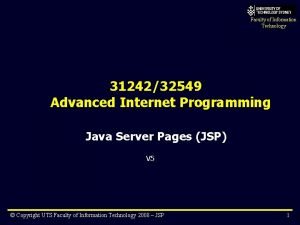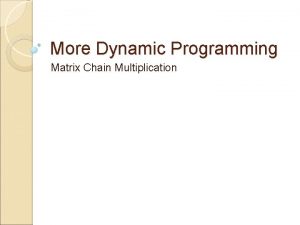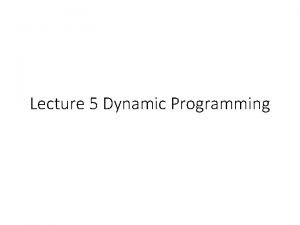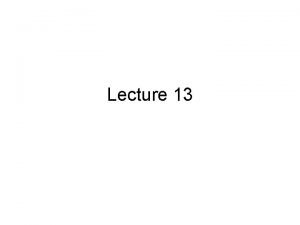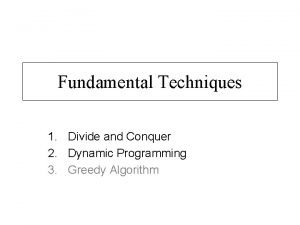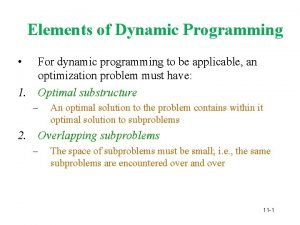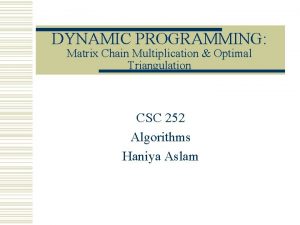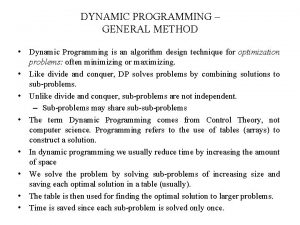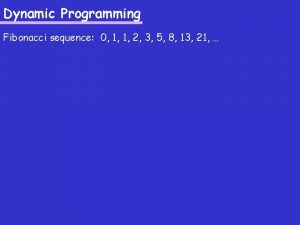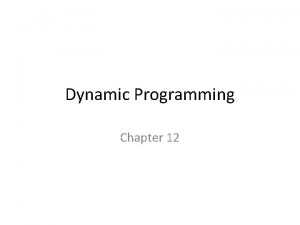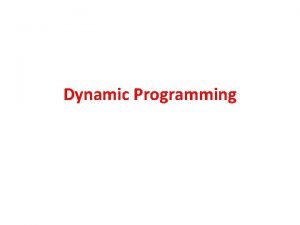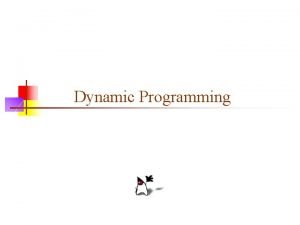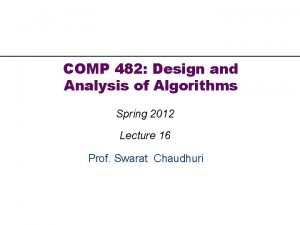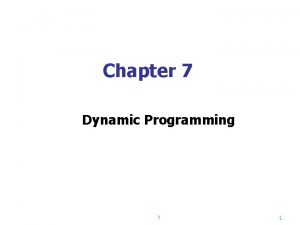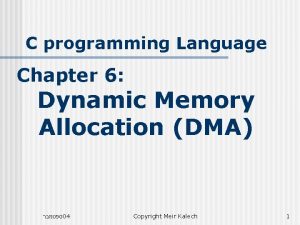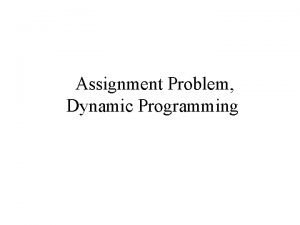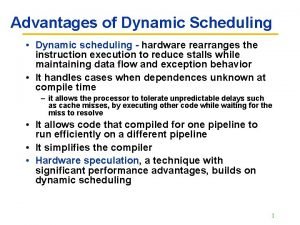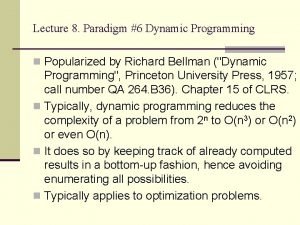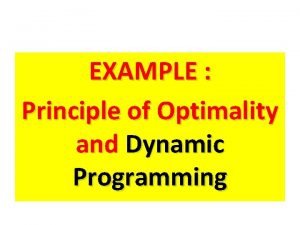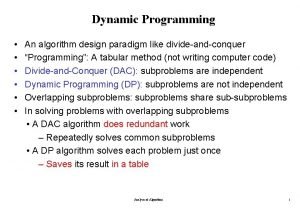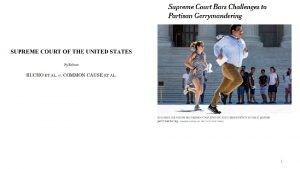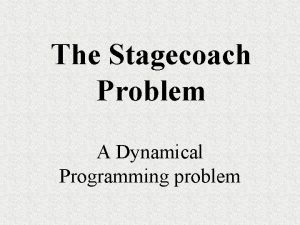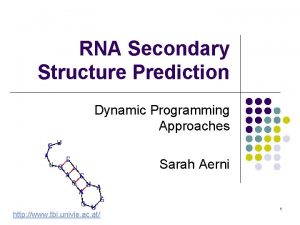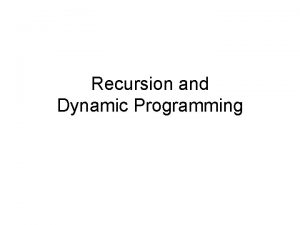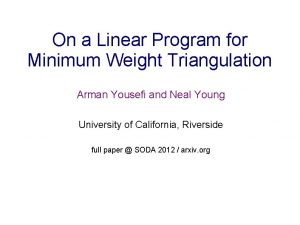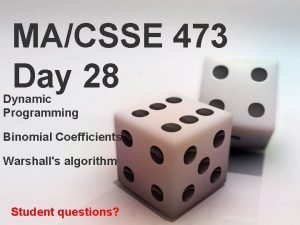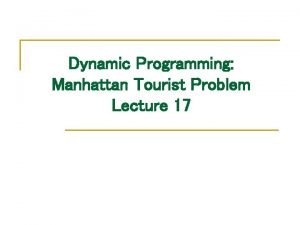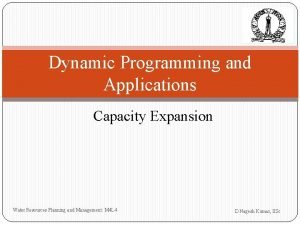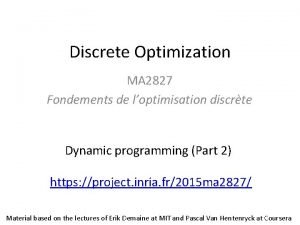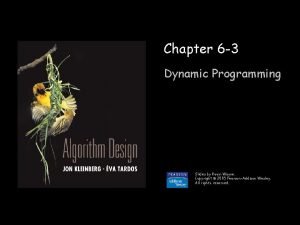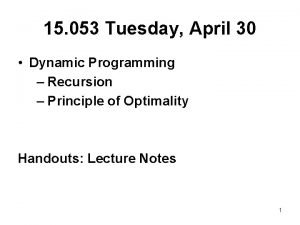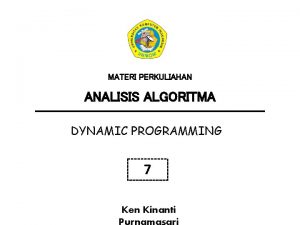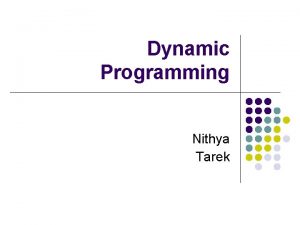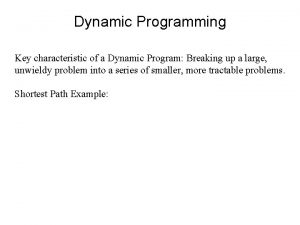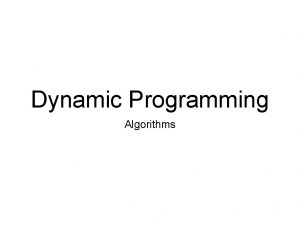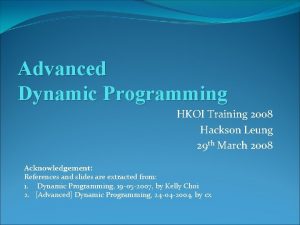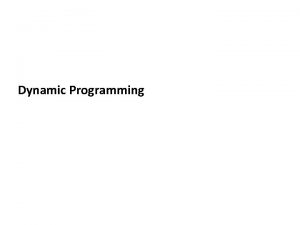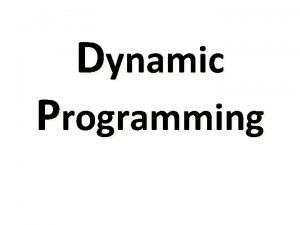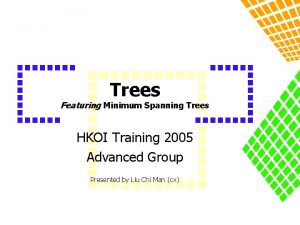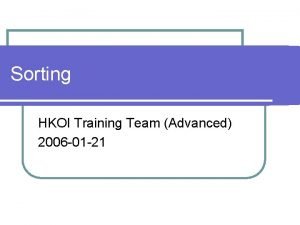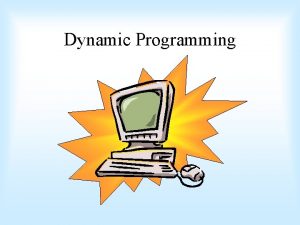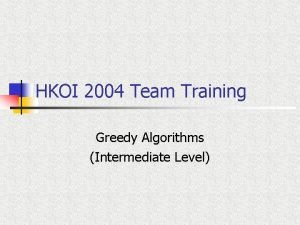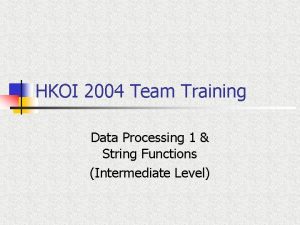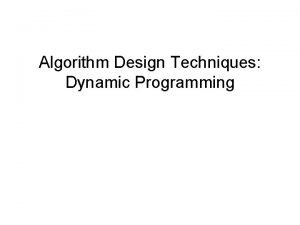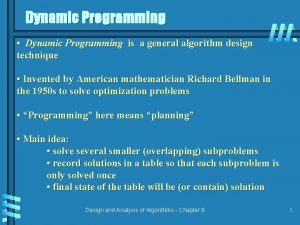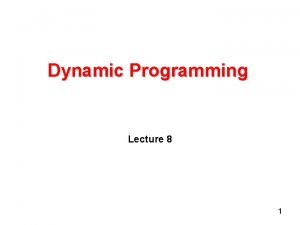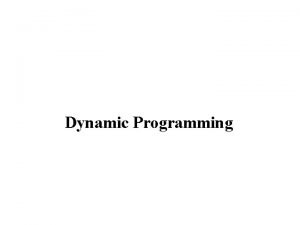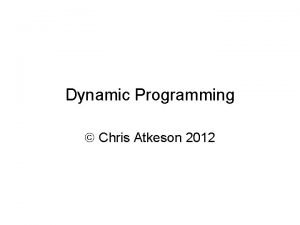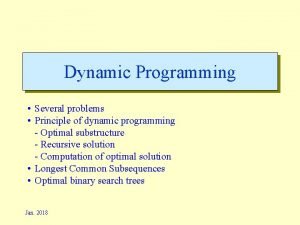Dynamic Programming I HKOI 2005 Training Advanced Group



























![Longest Common Subsequence • Explanation of the recurrence • If A[i] = B[j], then Longest Common Subsequence • Explanation of the recurrence • If A[i] = B[j], then](https://slidetodoc.com/presentation_image_h/871f798119a09f243b54223a1ca7a810/image-28.jpg)
![Longest Common Subsequence • Explanation of the recurrence • If A[i] B[j], then either Longest Common Subsequence • Explanation of the recurrence • If A[i] B[j], then either](https://slidetodoc.com/presentation_image_h/871f798119a09f243b54223a1ca7a810/image-29.jpg)























- Slides: 52

Dynamic Programming I HKOI 2005 Training (Advanced Group) Liu Chi Man, cx

Prerequisites • • Functions Recursion Divide-and-conquer Asymptotic notations – O, 2

Go, Go! • Recurrence relation • Dynamic programming 3

Recurrence Relation • A mathematical relationship expressing fn as some combination of fi with i < n • Eric W. Weisstein. "Recurrence Relation. " From Math. World--A Wolfram Web Resource. http: //mathworld. wolfram. com/Recurrence. Relation. html • An equation which defines a sequence recursively • “Recurrence relation. " Wikipedia: The Free Encyclopedia. 10 May 2005, 20: 00 UTC. 13 May 2005 <http: //en. wikipedia. org/wiki/Recurrence_relation>. • Examples • The Fibonacci numbers • F 0 = 0; F 1 = 1; Fn = Fn-1 + Fn-2 (for n = 2, 3, 4, …) • The sequence is (0, 1, 1, 2, 3, 5, 8, 13, 21, …) Base conditions Recurrence 4

Recurrence Relation • Examples • The positive integers • K 1 = 1; Kn = min { Ki Kn-i } + 1 (for n = 2, 3, 4, …) 1≤ i < n • The sequence is (1, 2, 3, 4, 5, …) • The product of two factorials • • H 0, 0 = 1; H 0, i = H 0, i-1 i (for i = 1, 2, 3, …); Hi, 0 = Hi-1, 0 i (for i = 1, 2, 3, …); Hi, j = Hi-1, j-1 i j (for i = 1, 2, 3, …; j = 1, 2, 3, …) 5

A Shortest Path Problem • Consider the network shown below, what is the shortest path distance from S to T? 9 1, 1 8 1 7 2 S 1 3 2 1, 3 3 4 4 5 1, 2 2 2, 1 6 1 3 2, 3 5 3 2 2 2, 2 6 3, 1 3, 2 2 2 T 1 3, 3 6

A Shortest Path Problem • Solutions • Enumeration • • How many different paths are there? 3 3 3 = 27 Very small~ but what if we have (1, 1) up to (7, 7)? 7 7 = 823543 Still not too big~ How about (100, 100)? 100100 = (1 googol)2 [Note: 1 googol = 10100] Exponential growth! 7

A Shortest Path Problem • Solutions • Any shortest path algorithm on general graphs • Dijkstra • Bellman-Ford • Warshall-Floyd • Standard enough, but we can solve this problem more efficiently by exploiting some of its special properties • The graph shown is a so-called “layered network” • Each arrow goes from one layer to the next layer 8

A Shortest Path Problem • Notation (for convenience) • c(u, v) = the cost of the arrow from node u to node v • Definition • D(k) = the shortest path distance from S to node k • Base condition • D(S) = 0 • Recurrences • D(1, 1) = D(S) + c(S, (1, 1)); • D(1, 2) = D(S) + c(S, (1, 2)); • D(1, 3) = D(S) + c(S, (1, 3)); 9

A Shortest Path Problem • Recurrences • D(2, 1) = min { D(1, 1) + c((1, 1), (2, 1)), D(1, 2) + c((1, 2), (2, 1)), D(1, 3) + c((1, 3), (2, 1)) }; • D(2, 2) = min { D(1, 1) + c((1, 1), (2, 2)), D(1, 2) + c((1, 2), (2, 2)), D(1, 3) + c((1, 3), (2, 2)) }; • Similar for D(2, 3), D(3, 1), D(3, 2), D(3, 3) and D(T) • Final answer • D(T) 10

A Shortest Path Problem • Running time analysis • For each of the (roughly) 3 3 nodes, we perform • 3 additions • 1 “min” operation on 3 numbers • Let’s generalize to n n nodes • For each of the (roughly) n n nodes, we perform • n additions • 1 “min” operation on n numbers • Overall time complexity = (n 3), assuming that the D(. ) in min{…} can be retrieved in constant time 11

Dynamic Programming • A method for reducing the runtime of algorithms exhibiting the properties of overlapping subproblems and optimal substructure • “Dynamic programming. " Wikipedia: The Free Encyclopedia. 7 May 2005, 20: 01 UTC. 13 May 2005 <http: //en. wikipedia. org/wiki/Dynamic_programming>. • In the previous example, why doesn’t our algorithm need to enumerate all possible paths from S to T? • Why we can compute D(2, 1) from D(1, 1), D(1, 2) and D(1, 3) so easily? 12

Optimal Substructure • A problem is said to have optimal substructure if its optimal solution can be constructed efficiently from optimal solutions to its subproblems • Optimal substructure. " Wikipedia: The Free Encyclopedia. 25 Mar 2005, 00: 48 UTC. 13 May 2005 <http: //en. wikipedia. org/wiki/Optimal_substructure>. • In other words, the subsolution of an optimal solution is an optimal solution of the corresponding subproblem optimal Problem Subproblem optimal Solution optimal Subsolution 13

Optimal Substructure • A subpath of a shortest path is a again a shortest path (between its two endpoints) • Proof: • Suppose P is a shortest path from a to b. Let Q be any subpath of P. Q goes from x to y. • What if Q is not a shortest path from x to y? That means there exists a shorter path Q’. • The blue path is shorter than P, which is a contradiction to the assumption “P is a shortest path from a to b”. Hence Q is a shortest path from x to y Q’ a x Q y b 14

Optimal Substructure • Thus the shortest path problem exhibits an optimal substructure • That’s why we can compute D(2, 1) from D(1, 1), D(1, 2) and D(1, 3) • Suppose we now want to compute D(m, k) • A path from S to (m, k) must path through either one of (m-1, 1), (m-1, 2), … , (m-1, n) • This implies that in particular, a SHORTEST path from S to (m, k) must path through one of those n nodes • But which one? ? 15

Optimal Substructure • How long is the shortest path from S to (m, k) passing through (m-1, i)? • From the optimal substructure, we know that the distance is D(m-1, i) + c((m-1, i), (m, k)) • D(m, k) is the minimum of these n distances, and we have obtained our recurrence 16

Optimal Substructure • Some problems do not exhibit optimal substructures • For example, finding a longest simple path in a graph between two nodes • A longest simple path from s to e is s b c d e • Is it true that b c is a longest simple path from d e b to c? c s b 17

Optimal Substructure • Let’s try (and fail) to set up a recurrence relation for the longest simple path problem • Definition • L(v) = the longest simple path distance from node s to node v • Base condition • L(s) = 0 • For the recurrence part, we use our previous reasoning… 18

Optimal Substructure • Let u 1, u 2, …, uk be the nodes preceding v • Then a longest simple path from s to v must pass through one of u 1, u 2, …, uk • How long is the longest simple path from s to v passing through u 1? • L(u 1) + 1 … Wait! What’s wrong? • v may lie on the longest simple path from s to u 1 • We cannot set up a recurrence easily • This is because of the absence of an optimal substructure 19

Overlapping Subproblems • Two subproblems may share a smaller subproblem • Consider our shortest path problem • Two of the subproblems are • Compute D(3, 1) • Compute D(3, 2) • They share some common subproblems • Compute D(2, 1) • Compute D(1, 3) • etc. 20

Overlapping Subproblems • Suppose we want to compute D(2, 1) and D(2, 2) • Computing D(2, 1) requires computing D(1, 1), D(1, 2) and D(1, 3), and each of them requires computing D(S) • Then we compute D(2, 2) • Computing D(2, 2) requires computing D(1, 1), D(1, 2) and D(1, 3), and each of them requires computing D(S) • Note the repetitions of computations! • Try to compute D(3, 1) and D(3, 2) 21

Overlapping Subproblems • We store every D(. ) in memory after computing its value • When computing a D(. ), we can simply retrieve previously computed D(. )s from memory, avoiding repeated computations of those D(. )s • So, for our shortest path problem, the D(. )s in min{…} can be “computed” in constant time • Our algorithm runs in (n 3) time! 22

How to Solve a Problem by DP? • Determine whether the problem exhibits an optimal substructure and has overlapping subproblems • If so, then it MAY be solvable by DP • Try to formulate a recurrence relation for the optimal solution (this is the most difficult step) • Based on the recurrence relation, design an algorithm that compute the function values in correct order • You are done 23

How to Solve a Problem by DP? • If you are experienced enough, you may write up the recurrence before you identify any optimal structure or overlapping subproblems • A problem may have many different formulations; some are easier to reach, while the others are easier to implement • Sometimes when you identify a problem as a DP-able problem, you are 90% done • We are going to see a few classical DP examples 24

Longest Common Subsequence • Given two strings A and B of length n and m respectively, find their longest common subsequence (NOT substring) • Example • • A: aabcaadyyyefg B: cdfehgjaefazadxex LCS: caaade Explanation • A: a a b c a a d y y y e f g • B: c d f e h g j a e f a z a d x e x 25

Longest Common Subsequence • Solution • Exhaustion • Number of subsequences of A = 2 n • Exponential time! • Optimal substructure • A: a a b c a a d y y y e f g • B: c d f e h g j a e f a z a d x e x • caa is the LCS of caabca and cdfehgjaefa • Proof: similar to the “shortest path” proof • Overlapping subproblems • Obvious 26

Longest Common Subsequence • Definition • Fi, j = length of LCS of A[1. . i] and B[1. . j] • Base conditions • Fi, 0 = 0 for all i • F 0, j = 0 for all j • Recurrence • Fi, j = Fi-1, j-1 + 1 (if A[i] = B[j]) max{ Fi-1, j , Fi, j-1 } (otherwise) • Answer • Fn, m 27
![Longest Common Subsequence Explanation of the recurrence If Ai Bj then Longest Common Subsequence • Explanation of the recurrence • If A[i] = B[j], then](https://slidetodoc.com/presentation_image_h/871f798119a09f243b54223a1ca7a810/image-28.jpg)
Longest Common Subsequence • Explanation of the recurrence • If A[i] = B[j], then matching A[i] and B[j] as a pair has no bad effect • A: ? ? ? ? x? ? ? ? • B: ? ? ? ? ? x? ? ? • How about the blue portion? • I don’t care, but according to the optimal structure, we should use the LCS of the two blue strings • Therefore we have Fi, j = Fi-1, j-1 + 1 28
![Longest Common Subsequence Explanation of the recurrence If Ai Bj then either Longest Common Subsequence • Explanation of the recurrence • If A[i] B[j], then either](https://slidetodoc.com/presentation_image_h/871f798119a09f243b54223a1ca7a810/image-29.jpg)
Longest Common Subsequence • Explanation of the recurrence • If A[i] B[j], then either A[i] or B[j] (or both) must not appear in a LCS of A[1. . i] and B[1. . j] • If A[i] does not appear (B[j] MAY appear) • • A: ? ? ? ? x? ? ? ? B: ? ? ? ? ? y? ? ? LCS of A[1. . i] and B[1. . j] = LCS of blue strings Fi, j = Fi-1, j • If B[j] does not appear (A[i] MAY appear) • • A: ? ? ? ? x? ? ? ? B: ? ? ? ? ? y? ? ? LCS of A[1. . i] and B[1. . j] = LCS of blue strings Fi, j = Fi, j-1 29

Longest Common Sequence • Can we compute Fn, m directly? • No, we need to compute Fn-1, m, Fn, m-1, Fn-1, m-1 first • Therefore we must compute the Fs in the “safe” order • For example, we can compute the Fi, js in increasing order of i and j • Now I know the length of the LCS, but how to obtain the LCS? • Exercise 30

Longest Common Subsequence • Store base conditions in memory for i = 1 to n do for j = 1 to m do Compute Fi, j Store Fi, j in memory The answer is Fn, m • Time complexity = (nm) • Space complexity = (nm) • Can be reduced to (min{n, m}) • Wait for DP 2 31

Stones • There are n piles of stones in a row • The piles have, in order, a 1, a 2, …, an stones respectively • You can merge two adjacent piles of stones, paying a cost which is equal to the number of stones in the resulting pile • Find the minimum cost to merge all stones into one single pile 32

Stones • Sample play • • • 41275 4375 7 12 19 Total cost = 3 + 7 + 12 + 19 = 41 • Does a greedy strategy always work? 33

Stones • Suppose after some moves, there are m piles left and the numbers of stones in the piles are b 1, b 2, …, bm • Each bi corresponds to a contiguous sequence of original (unmerged) piles • Example: • 876123123435 • 15 12 1 2 7 8 34

Stones • Optimal substructure • Suppose in an optimal (minimum cost) solution, after some steps, there are m piles left • Choose one of these piles, say p • Suppose p corresponds to original piles s, s+1, …, t • We claim that in the optimal solution, the sequence of moves that transform original piles s, s+1, …, t into p is an optimal solution to the subproblem [as, as+1, …, at] • The proof is trivial 35

Stones • Overlapping subproblems • Obvious • Definition • Ci, j = minimum cost to merge original piles i, i+1, …, j-1, j into a single pile • Base conditions • Ci, i = 0 for all i • Recurrence (for i < j) j • Ci, j = min { Ci, k + Ck+1, j + ax } i≤k<j • The answer is C 1, n x=i 36

Stones • Explanation of the recurrence • To merge original piles i, i+1, …, j, there must be a (final) step in which we merge two piles into one • Let the two piles be p and q, where p corresponds to original piles i, i+1, …, k and q corresponds to original piles k+1, k+2, …, j j • The cost to merge p and q = ax x=i • The minimum cost to construct p = Ci, k • The minimum cost to construct q = Ck+1, j • By the optimal substructure, the total cost is j Ci, k + Ck+1, j + ax x=i 37

Stones • In what order we should compute Ci, j? • Increasing i and j? No! • Recall: what does Ci, j depend on? • We can compute Ci, j in increasing (j-i) order We are computing this . . . and we need these . . . i i+1 i+2 i+3 i+4 j-2 j-1 j 38

Stones • To avoid all the fuss in the previous slide, we may use a top-down implementation • function get. C(i, j) { if Ci, j is already computed, Return Ci, j otherwise Compute Ci, j using get. C() calls Store Ci, j in memory Return Ci, j } • No need to care about the order of computations! 39

Stones • Time complexity = (n 3) • By using a really clever trick (quadrangle inequality) we can modify the algorithm to run in (n 2), but that’s too far from our discussion • Space complexity = (n 2) • You may try another formulation • Define C’i, h = minimum cost to merge original piles i, i+1, i+2, …, i+h-1 into a single pile • What are the advantages and disadvantages of this formulation? 40

Speeding Up Computation of R. F. • The computation of some recursive (mathematical) functions (e. g. the Fibonacci numbers) can be sped up by “dynamic programming” • However, this computation does not exhibit an optimal substructure • In fact, optimality doesn’t mean anything here • We make use of memo(r)ization (storing computed values in memory) to deal with overlapping subproblems 41

Memo(r)ization • To be precise, we use the term memoization or memorization to refer to the method for speeding up computations by storing previously computed results in memory • The term memoization comes from the noun memo • The term dynamic programming refers to the process of setting up and evaluating a recurrence relation efficiently by employing memo(r)ization 42

Memo(r)ization • However, in reality, memo(r)ization is often replaced by dynamic programming • Let’s start the good(? ) practice in HKOI • HKOI DP Revolution of 2005 • We: Orz 43

0 -1 Knapsack • The notion of subproblems is not very obvious in some problems • There are n items in a shop. The i-th item has weight wi and value vi. A thief has a knapsack which can carry at most a weight of W. What should she steal to maximize the total value of the stolen items? • Assumption: all numbers in this problem are positive integers • Bonus exercise: what does 0 -1 mean? 44

0 -1 Knapsack • What is a subproblem? • Less weight, fewer items • Identify the optimal substructure • Exercise • Definition • Ti, j = maximum value she gains if she is allowed to choose from items 1, 2, …, i and the weight limit is j • T’i, j = maximum value she gains if item i is the largest indexed item chosen and the weight limit is j • Which one is better? 45

0 -1 Knapsack • Base conditions • Ti, 0 = 0 for all i • T’i, 0 = 0 for all i • Recurrence (for i, j > 0) • Ti, j = max { Ti-1, j, Ti-1, j-wi + vi } Ti-1, j • T’i, j = max { Tk, j-wi + vi } 1 ≤ k < i, T >0 vi 0 k, j-wi (if wi ≤ j) (otherwise) (if wi < j) (if wi = j) (otherwise) 46

0 -1 Knapsack • Time complexity • T version – O(n. W) • T’ version – O(n 2 W) • T’ is much more difficult to formulate and results in a higher time complexity • This shows that the definition of the optimal function should be chosen carefully • Again, it is your exercise to give an algorithm to construct the optimal set of chosen items 47

0 -1 Knapsack • In the Branch-and-Bound lecture I was told that the 0 -1 Knapsack problem is NP-complete, but why there exists a polynomial-time DP solution? • Polynomial in which variables? • What assumptions have we made in the problem statement? 48

Phidias • An easy problem at IOI 2004 • Phidias (an ancient Greek sculptor) has a big rectangle of size W H. He wants to cut the rectangle into small rectangles. Each small rectangle should have size W 1 H 1, or W 2 H 2, …, or Wn Hn. If any piece left is not of any of those sizes, then it is wasted. Phidias can only cut straight through a rectangle (parallel to a side of the rectangle), leaving two smaller rectangles. What is the minimum possible wasted area? 49

Phidias • Subproblem: cutting a smaller rectangle • Optimal substructure: Phidias cut according to an optimal solution. After some cuts, choose any one rectangle. In the optimal solution, this rectangle is going to be cut in a way that the wasted area is at minimum (concerning only this rectangle). • Proof: trivial, because how this rectangle is cut should be independent of other rectangles left 50

Phidias • Definition • Ph, w = min. wasted area if a h w rectangle is cut • Base conditions • P 1, 1 = 0 1 • PHi, Wi = 0 (if 1 1 is one of the n desired sizes) (otherwise) (for 1 ≤ i ≤ n) • Recurrence • Ph, w = min { 1 min { Pk, w + Ph-k, w }, 1 min { Ph, k + Ph, w-k } } ≤k<w ≤k<h • Answer • PH, W 51

Looking forward… • Topics going to be covered in Dynamic Programming II • • Fantastic DP formulations Dimension reduction in space DP on trees and graphs and hopefully, minimax for two-person games 52
 Dynamic programming bottom up
Dynamic programming bottom up Greedy algorithm vs dynamic programming
Greedy algorithm vs dynamic programming Hkoi solution
Hkoi solution Judge.hkoi
Judge.hkoi Hkoi solution
Hkoi solution Hkoi
Hkoi Hkoi judge answer
Hkoi judge answer Hkoi
Hkoi Advanced internet programming
Advanced internet programming A simple assembly scheme in system software
A simple assembly scheme in system software Assembly language programming
Assembly language programming Advanced programming in java
Advanced programming in java Transferered
Transferered Tabulation in dynamic programming
Tabulation in dynamic programming Matrix chain multiplication formula
Matrix chain multiplication formula A b a b c d e
A b a b c d e Mathematical formulation of dynamic programming
Mathematical formulation of dynamic programming Dynamic programming bottom up
Dynamic programming bottom up What are the elements of dynamic programming
What are the elements of dynamic programming Dynamic programming vs divide and conquer
Dynamic programming vs divide and conquer General method of dynamic programming
General method of dynamic programming Dynamic programming excel
Dynamic programming excel Fibonacci with dynamic programming
Fibonacci with dynamic programming Egg drop dynamic programming
Egg drop dynamic programming Dynamic programming vs divide and conquer
Dynamic programming vs divide and conquer Dynamic programing
Dynamic programing 4d3d41669541f1bf19acde21e19e43d23ebbd23b
4d3d41669541f1bf19acde21e19e43d23ebbd23b Backward approach in multistage graph
Backward approach in multistage graph Dynamic c programming
Dynamic c programming Assignment problem dynamic programming
Assignment problem dynamic programming Benefits of dynamic scheduling software
Benefits of dynamic scheduling software Dynamic problem
Dynamic problem Dynamic programming paradigm
Dynamic programming paradigm Principle of optimality
Principle of optimality Dynamic programming paradigm
Dynamic programming paradigm Disadvantages of dynamic array
Disadvantages of dynamic array Gerrymandering dynamic programming
Gerrymandering dynamic programming Stagecoach problem
Stagecoach problem Canonical base
Canonical base Recursive thought
Recursive thought Minimum weight triangulation dynamic programming
Minimum weight triangulation dynamic programming Binomial coefficient using dynamic programming
Binomial coefficient using dynamic programming Manhattan problem
Manhattan problem Dynamic programming recursion example
Dynamic programming recursion example Discrte
Discrte Dynamic programming slides
Dynamic programming slides Bh&m
Bh&m Dynamic programming equation
Dynamic programming equation Dynamic programming
Dynamic programming Dynamic programming
Dynamic programming Characteristics of dynamic programming
Characteristics of dynamic programming Dynamic programming in excel
Dynamic programming in excel Dynamic programming
Dynamic programming








